Sarcocornia is a formerly recognized genus of flowering plants in the amaranth family, Amaranthaceae. Species are known commonly as samphires, glassworts, or saltworts. Molecular phylogenetic studies have shown that when separated from Salicornia, the genus is paraphyletic, since Salicornia is embedded within it, and Sarcocornia has now been merged into a more broadly circumscribed Salicornia. When separated from Salicornia, the genus has a cosmopolitan distribution, and is most diverse in the Cape Floristic Region of South Africa.

The Chenopodioideae are a subfamily of the flowering plant family Amaranthaceae in the APG III system, which is largely based on molecular phylogeny, but were included – together with other subfamilies – in the family Chenopodiaceae, or goosefoot family, in the Cronquist system.

Ptilotus is a genus of approximately 125 species of flowering plants in the family Amaranthaceae, and is endemic to Australia, apart from Ptilotus conicus that also occurs in Malesia. Plants in the genus Ptilotus are annual or perennial herbs or shrubs with usually hairy spikes of compact spherical, oval or cylindrical flowers.

Grayia is a genus of plants in the subfamily Chenopodioideae of the family Amaranthaceae. Common names are siltbush and hopsage. The four shrubby species occur in arid and semiarid regions of western North America:

Grayia spinosa is a species of the genus Grayia in the subfamily Chenopodioideae of the flowering plant family Amaranthaceae, which is known by the common names hop sage and spiny hop sage. It is widely distributed across the Western United States, where it grows in a number of desert and mountain habitats.
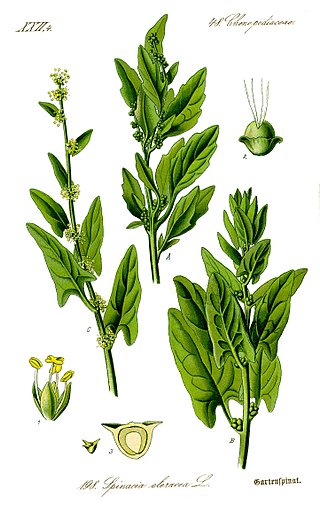
Spinacia is a flowering plant genus in the subfamily Chenopodioideae of the family Amaranthaceae. The most common member is spinach.

Soda stocksii is a shrub species of the family Amaranthaceae.

Suaeda aegyptiaca is a species of succulent plant in the family Amaranthaceae, and salt-tolerant (halophyte) plant that is distributed in eastern North Africa, the Near East and West Asia.
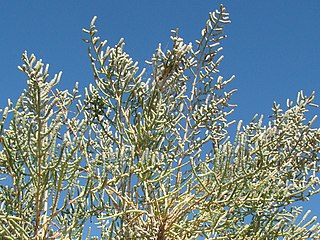
Halostachys is a genus of flowering plants in the plant family Amaranthaceae, containing a single species, Halostachys caspica. The plants are small to medium halophytic shrubs with apparently jointed fleshy stems and scale-like leaves. They are native to western and central Asia and northern China.

Kalidium is a genus of flowering plants in the plant family Amaranthaceae. The species are shrubby halophytes distributed in Southeast Europe, Southwest Asia and Central Asia to China.

Chenopodiastrum is a genus of herbaceous flowering plants in the family Amaranthaceae. The genus was formally described in 2012. The five species occur in both the Old World and North America.

Lipandra polysperma, common name manyseed goosefoot, is the only species of the monotypic plant genus Lipandra from the subfamily Chenopodioideae of the family Amaranthaceae.

Halimione is a plant genus from the subfamily Chenopodioideae of the family Amaranthaceae. It is a sister genus of Atriplex and is included in that genus by Plants of the World Online.
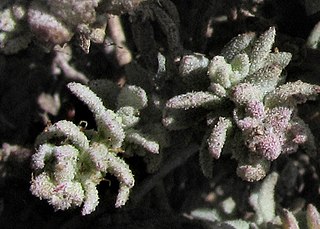
Extriplex is a plant genus in the subfamily Chenopodioideae of the family Amaranthaceae. It has been described in 2010 and comprises two species, that were formerly included in genus Atriplex. They are restricted to the California Floristic Province.

Stutzia is a plant genus in the subfamily Chenopodioideae of the family Amaranthaceae. It was described in 2010, replacing the illegitimate name Endolepis. It comprises two species, that have also been included in the genus Atriplex.

Proatriplex is a monotypic plant genus in the subfamily Chenopodioideae of the family Amaranthaceae, with the only species Proatriplex pleiantha. It is known by the common names four-corners orach and Mancos shadscale. It occurs in the Navajo Basin of Arizona, Colorado, New Mexico, and Utah.
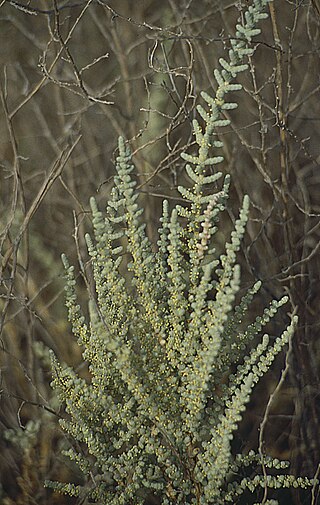
Halocnemum is a genus of halophytic shrubs in the family Amaranthaceae. The plants are fleshy and apparently articulated with characteristic globular or short-cylindrical lateral branches, and reduced leaves and flowers. There are three or two species, occurring from Southern Europe and North Africa to Asia.

Halopeplis is a genus in the family Amaranthaceae. The plants are halophytes with not articulated stems and fleshy stem-clasping leaves. There are three species, occurring from the Mediterranean basin and North Africa to Southwest Asia and Central Asia.
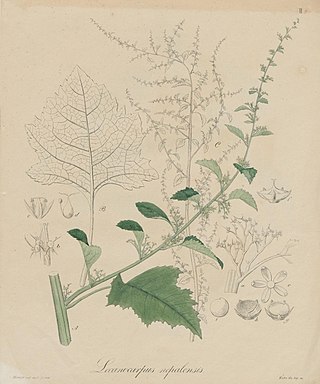
Acroglochin persicarioides is a species of flowering plants in the plant family Amaranthaceae. It is distributed from the Himalayas to China. The systematic position of the genus Acroglochin in subfamily Betoideae is still uncertain.

Atriplex angulata, commonly known as fan saltbush or angular saltbush, is a species of flowering plant in the family Amaranthaceae. It is an annual to short-lived perennial subshrub, native to Australia, distributed throughout drier parts of the mainland.


















